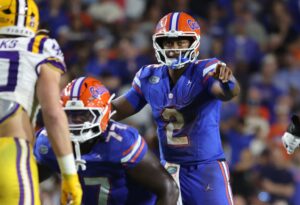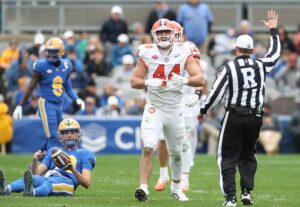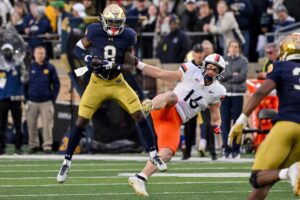As the Pac 12 cancels all Fall sports, (yes, we know they are calling it a postponement), it leaves a lot of financial questions going forward for every conference school. Some have bigger questions than others.
Pac 12 Money Woes
Cal is engaged in a lawsuit with Under Armour over a contract that was never actually signed. The apparel company refuses to admit its very existence is in jeopardy, and is just pushing its client schools into a financial fight. It is using Force Majeure (act of God) clauses from a contract that no one signed, to try to get out of its payments due to Cal.
The one-time apparel giant has given the school notice it will opt out of its $280 million deal with UCLA. When it was signed in 2017 it was the largest such deal of any school in the country. It was also folly. There was no conceivable reason to believe any apparel company not named Nike could actually complete a 15-year deal for that kind of money. None the less, UCLA frontloaded some of the annual money, and now the two are headed for divorce. They are yet not in legal entanglements. Neither can afford extended legal fees.

Even if UCLA wanted to fulfill the contract for the upcoming academic year, there will be no football, women’s volleyball, women’s soccer, or cross country. There won’t be any Bruins on any field or court wearing Under Armour gear until at least January. Act of God, indeed. UCLA has seen the last of the Under Armour money while it tries to negotiate a new deal with another company; a company that will come in for dimes on the dollar compared to the prior contract. UCLA is in a weak leverage point now. The future of Bruins’ athletes in sanctioned competition is very much up in the air, as it is throughout the Pac 12.
Stanford, a school that has private endowments for many Olympic sports has cut 11 of them already. The current athletes will be on scholarship through the end of the academic year, but their futures are in question. Stanford, a school of great wealth, also cut more than 200 employees earlier this month. It is also planning for the permanent elimination of 400 currently vacant jobs.
USC, the other financial blueblood in the conference has crunched it numbers. It estimates that with COVID costs, the massive reduction in housing revenue and other on-campus sources, the lessening of money from donors, and the loss of athletic revenue, the school stands to lose as much as $500 million this academic year, according to a letter issued by the Provost.
Tough Times Are Already Here For UCLA
So, where does that leave UCLA, an athletic department that was currently living in a financial morass? The Bruins already had to take an $18 million dollar interest bearing loan from the university to cover a deficit in fiscal year 2019. How, when, or if they pay it back is an open-ended question. The traditional revenue sports are more of a drain than an asset right now. Football attendance in 2019 was woeful, but the costs to run the program didn’t shrink in any equal measure. The basketball team got hot at the end of the season. But attendance lagged early. Then they lost out on March Madness revenue when the tournament was cancelled. That is a loss of their individual take as a participant, as well as their cut of overall Pac 12 revenue from the tournament.
Now the university has a looming financial crisis of its own. It lost millions of dollars in the Spring as the virus hit and students and staff were forced to covert to on-line learning. The cost of the conversion, new cybersecurity measures, and the expense of treating infected students were unforeseeable expenses. The federal government gave money to all schools across the country in the initial CARES rescue package. Half of the money was for the schools, and half had to be directed to each individual student. There is no sense there is a second bailout for schools in the currently stalled rescue package.
UCLA is going to hybrid mode for classes in the Fall quarter later next month. Some will be in person, and some will be online. They anticipate only 5,000 students to be occupying the on-campus housing. That is less than 50% of the normal 11,000. The school is going to take a significant loss in housing revenue, on-campus activities, and lack of sports. And now it has a debtor, its own athletic department, that is in no position to “pay back” the money it owes.
Is There A Financial Fix For Athletics
How does the athletic department right its financial world? Well, maybe they can play football in the Spring. It isn’t a very good idea, but some smaller conferences may do it. It was dangled as a carrot by all the conferences that did cancel the Fall schedule. But as we have said repeatedly, you would be asking most of your roster to play in the Spring and again the following Fall. That is around 20+ games in one calendar year, with a minimal break in between. It’s inconceivable to cancel one season for the health and safety of the players, and then schedule two seasons into on calendar year, ignoring their health and safety.
Big 10 commissioner Kevin Warren suggested the Spring season as did Pac 12 commissioner Larry Scott. While Warren did a pre-taped video message for the cancellation announcement, Scott held a press conference. When queried on the issue of playing two seasons in one calendar year, he admitted, “You have identified one of the reasons why considering the Spring was not one of the things you wanted to default to right away.”
Plus, there has been no commitment from ESPN/ABC to Spring football coverage. Recouping lost revenue from the Fall is the only logical reason to even think about Spring. Without the guarantees, why bother?
The Conference “Bailout” Plan
There is the possibility of the Pac 12 bailout plan. It has been reported that Scott has discussed with several of the conference schools that the Pac 12 could provide $1 billion across all 12 campuses to help with the athletic revenue shortfalls. The only problem is the conference does not have $1 billion to loan. It is horribly cash strapped itself. It would first have to borrow the money, and then turn it around to the schools at a reported 3½ % interest over three years. The Gambino family would have been proud to get a vig like that. But who is going to loan the conference headquarters money? They are in the midst of budget cuts and layoffs. Their tv network is hanging on by a thin thread. And how would schools repay it when their finances are going deeper into the red?
The Pac 12 is in no position to help anyone. This time last year Scott was on a road show, going to investment firms asking for $750 million in angel investment money. He had nothing to offer in return except maybe a paltry 2% return on investment. Predictably he got turned down at every stop.

It was reported that an obstacle was that UCLA and USC wouldn’t sign 25-year commitments to the conference. That may be. But the actual reason he got turned down was because he had nothing to give in return. Investment firms that are prepared to bankroll that kind of money want seats at the table. They often take 2-3 seats on the board of directors. They want to control the path of the company in which they are investing. Scott has no such seats to give. No equity firm was going to give him $750 million and let him continue to run it in the same fashion that put him in this predicament.
We contacted the UCLA athletic department to get their insights on the reported loan program. We were told athletic director Martin Jarmond would have no further comment on the financial issues beyond what he said at his press gaggle the day of the Pac 12 cancellation announcement. At that time, early last week, Jarmond said, “We have obviously been modeling different scenarios based on the season, based on competition. Not just revenues but expenses.”
Where Do We Get Money From?
Just because they are not playing, does not mean there is not overhead. The coaches are all still getting paid. And the highest paid athletic director in UCLA history is still getting his paycheck. The expenses are significant. Jarmond was pragmatic last week. “We all understand how financially significant those Fall sports are and its going to be a challenge.” As things in college football change weekly, the problems could get worse. When we spoke with him after he first got the job, he was committed to trying to keep all the non-revenue sports. That was then. This is a COVID budget now.
So, the UCLA athletic department had to borrow money from the school to get out of the red. It is now going to go back into the red with the loss of Fall sports revenue. Spring football is but a fantasy plan right now. The planned partial basketball season can make a minor dent, but nothing more. The school is hemorrhaging money itself, and likely facing state budget cuts. Not only is it not in a position to help you out again, but would really like you to “pay back” the money you already owe. And the Pac 12, the conference that can barely afford its high-end San Francisco office space, has no one thus far willing to give it money, to then give to you. And since you, the school, have no immediate ability to pay it back anyway, does it really matter?

Best Case Scenario Is For Others To Fail
The best case scenario for UCLA in the immediate future, while they likely would not admit it, is for the SEC, ACC, AAC, Big XII, and others to fail in their efforts to have Fall football. It could force ESPN’s hand to support Spring football. The Pac 12 has a contract with ESPN. The ACC and SEC have an actual partnership with them in their conference networks. If they pull off the Fall, and it is a big if, the ratings will be huge. There will be an audience concentration on fewer games. The Big 10, the Pac 12, and within that, UCLA, will get left behind. If they fail to play in the Fall, then there is potential financial help for UCLA, maybe about six months from now.






